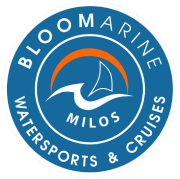RENT A BOAT
7 Hidden Spots You’ll Only See on Milos Boat Tours in 2025
Mykonos and Santorini draw huge crowds, but Milos keeps its hidden wonders tucked away along its beautiful 125-kilometer coastline. Our Milos boat tours take you to more than 70 beaches and secret spots that most travelers miss completely.
The island's coastline reveals amazing stories at every turn. You'll see the old pirate hideouts of Kleftiko with stunning white rock formations and the breathtaking entrance of Sikia Cave. We know these waters inside out, and our private boat tours cost €90 per person with small groups of 8 or fewer. These waters become even more magical during peak season from late May to mid-September. The volcanic island's dramatic shores remain one of Greece's best-kept secrets.
Here are 7 hidden spots that show why Milos should be at the top of your 2025 travel list.
The Mystical Blue Cave: Milos' Answer to Capri
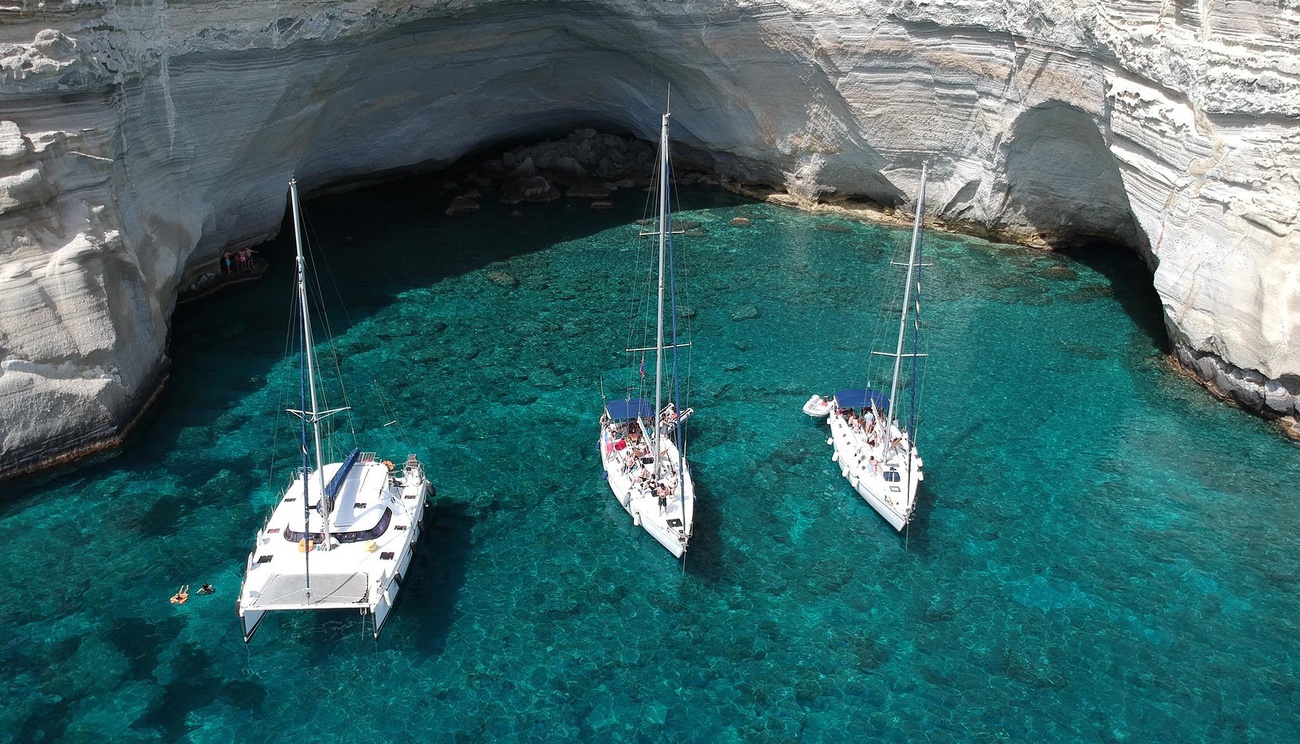
Image Source: You Know! Boat Sorrento
A magical sea chamber sits in Milos's southwestern corner that matches Italy's famous Grotta Azzurra. Sykia Cave, which locals also call the Emerald or Blue Cave, gives visitors an exceptional experience. This hidden gem remains uncrowded compared to its Italian counterpart. My experience exploring Mediterranean caves has shown that it offers an equally captivating experience with fewer tourists.
Blue Cave Location and Access
This secluded wonder needs some effort to reach, which keeps most standard tourist routes away from it. Sykia Cave sits in Milos's southwestern region. Boats provide the only way to reach it since no roads or paths come close enough. Most private boat tours make this cave an important stop on their routes. The cave becomes a highlight of any detailed island exploration.
Boats can enter through a natural arch at the entrance but can't go too deep inside because of a partially collapsed ceiling. This unique feature creates perfect conditions for impressive light effects that make the cave famous. Make sure to ask about time allowances at Sykia Cave when booking a milos boat tour. The best tours give you enough time to swim and take photos.
What Makes This Cave Unique
Sykia stands out from other sea caves because of its remarkable ceiling opening. This natural skylight appeared when part of the roof fell in. Sunlight streams through this opening and creates an otherworldly atmosphere inside. Light comes in through both the ceiling hole and underwater entrance. It bounces off the white cave floor and fills the entire grotto with mesmerizing blue light.
The walls reflect the turquoise water, which led to the name "Emerald Cave". German painter August Kopischa found the Blue Grotto of Capri in 1826. Sykia offers more freedom than Capri's cave - you can swim here without many restrictions. The cave also provides a calm, cool space away from the Mediterranean sun.
Comparison: Sykia Cave vs. Capri's Blue Grotto
| Feature | Sykia Cave (Milos) | Blue Grotto (Capri) |
|---|---|---|
| Access | Boat entry through natural arch | Small boat through narrow opening |
| Ceiling | Partially collapsed, natural skylight | Intact with submarine-like opening |
| Swimming | Allowed and encouraged | Restricted |
| Crowds | Relatively uncrowded | Can have hour-long waits |
| Best viewing time | Around sunset | Noon to 2 PM |
Best Time of Day for Blue Cave Visits
Your visit's timing matters at Sykia Cave. The most enchanting experience comes around sunset. The sun's rays angle through the cave's ceiling hole and create magical patterns in the water. These hours show the most dramatic color effects. Turquoise waters glow vividly against the cave walls.
Capri's Blue Grotto shows its best between noon and 2 PM. Sykia's late afternoon light creates more varied blues and greens. Tourist boats usually head back to port by this time, so you'll get a more private experience.
Photography Tips for Capturing the Blue Glow
Sykia Cave's ethereal blue glow presents unique photography challenges. These techniques will help you capture stunning images:
- Use a waterproof camera or phone case to shoot both above and below the waterline
- Set your white balance manually rather than auto to capture the true blue tones
- Increase your ISO setting to compensate for the dimmer light inside the cave
- Shoot in RAW format if possible to allow for post-processing adjustments
- Time your visit for when sunlight streams through the ceiling opening for dramatic light rays
The best shots come from spots where light beams cut through the water. Some milos boat tours stops include morning and afternoon visits to capture different lighting conditions.
Snorkeling near the cave entrance offers another great photo opportunity. Underwater shots reveal a different world. Blue light pierces the depths and creates surreal underwater landscapes. Clear water makes it perfect to capture light playing with ancient volcanic rock formations.
Sikia Cave's Hidden Chambers: Beyond the Main Attraction
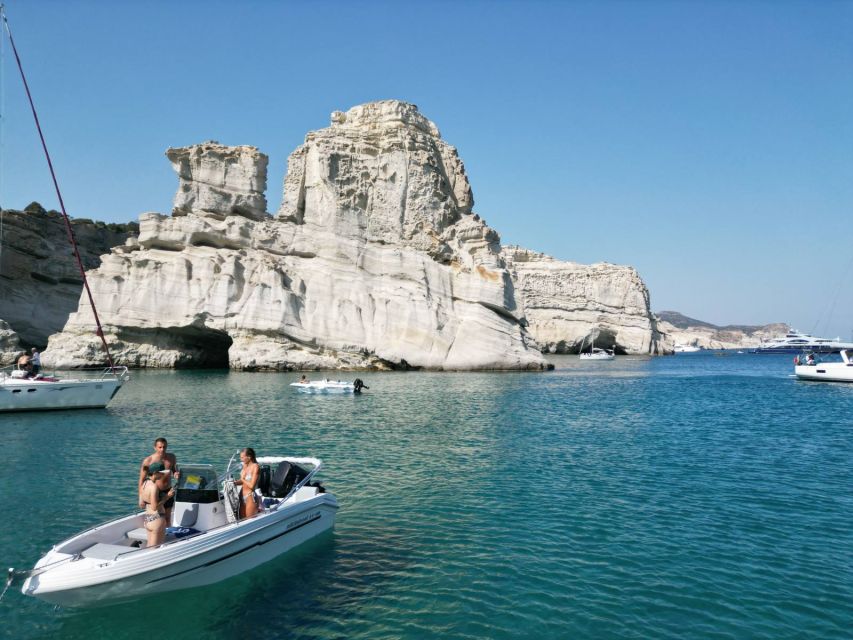
Image Source: Power Traveler
The famous blue glow and natural skylight of Sikia Cave lead to a network of hidden chambers that few people ever find. My multiple trips to this remarkable sea cave have revealed geological wonders that standard milos boat tours don't give guests enough time to see.
The Secret Entrance Only Locals Know
The main entrance to Sikia Cave stands impressive with its massive dimensions - 5 meters high and 20 meters wide. Local guides showed me a second entrance that tourists rarely know about. This hidden spot requires you to direct yourself through a narrow passage next to the cave's rugged cliff face.
Most boat tour milos operators drop anchor outside the main entrance. They only give enough time to see the collapsed ceiling and swim in the main chamber. In spite of that, seasoned captains who know the cave's secrets will take you to the hidden entrance. They usually use small dinghies or rafts that can squeeze through tighter spaces.
Small outboard motors are the only vessels that can pass through this special entrance. Larger boats must stay outside. Adventurous souls who swim a short distance will see chambers untouched by regular tourists.
Geological Formation of the Hidden Chambers
Volcanic activity and water erosion shaped Sikia Cave's interior network over thousands of years. The cave system consists of volcanic rock that wind and water sculpted through centuries. These hidden chambers reveal:
- An intricate network of tunnels that connect various rooms
- Impressive stalactites that hang from the ceiling and stalagmites that rise from the floor
- A large central chamber that reaches over 30 meters high
The geology here tells an amazing story. The inner chambers stay fully enclosed, unlike the main chamber with its collapsed roof. This creates unique microclimates and lighting conditions. Water drips through porous volcanic rock to form stalactites and stalagmites. These minerals slowly build distinctive formations.
These hidden chambers remain pristine. The rock formations keep their natural state without direct sunlight or frequent visitors. They show vibrant colors and textures that look almost otherworldly when lit by underwater torches during milos private boat tours.
Swimming Through Crystal Waters to Reach the Chambers
Crystal clear waters guard the path to these secret chambers. The inner chambers keep steady temperatures year-round, unlike the main area of Sikia Cave where limited sunlight makes the water quite cold.
The underwater passage creates an unforgettable snorkeling experience. The crystal-clear waters reflect beautiful colors against the chamber walls. These reflections give the cave its other name, "The Emerald Cave".
The best way to experience the hidden chambers:
- Pick a milos boat tours stops route that includes Sikia's interior chambers
- Take underwater lights to see all colors and formations
- Use rock shoes to walk safely on the small stone beach inside
- Visit in late afternoon to catch magical light effects
These hidden chambers reward patient explorers, unlike other spots such as kleftiko milos where tours often feel rushed. The underwater lake mirrors the stalactites above. This symmetry adds to the cave's mystical feel.
Most people see only the main section with its dramatic skylight. They miss the chance to explore these quiet chambers where nature shows its best work. Private boat tours that spend enough time at Sikia offer the best way to see these hidden treasures beyond the main attraction.
Polyaigos Hidden Lagoons: The Uninhabited Island's Secrets
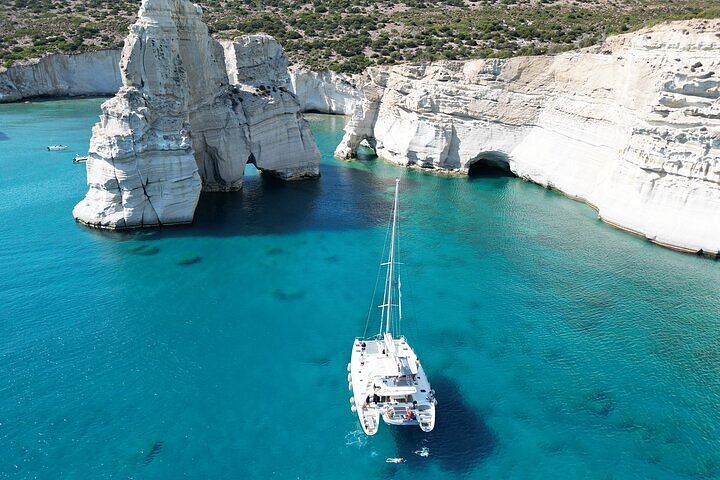
Image Source: Tripadvisor
Polyaigos, the largest uninhabited island in the Cyclades, lies 6.2 kilometers east of Milos. Its turquoise lagoons remain unexplored by standard tour groups. My exploration of these pristine waters showed why this ecological haven deserves a spot on any Aegean explorer's list.
Why Most Boat Tours Miss These Lagoons
Standard milos boat tours barely touch Polyaigos. They visit one or two spots quickly before leaving. The island's hidden lagoons stay hidden behind towering white vertical cliffs that rise above the sea.
Tour operators give only one or two hours at Polyaigos. This short time makes it impossible to explore beyond common areas. Small vessels are needed to reach the most secluded lagoons through narrow rock passages. Some areas become available only during specific tidal conditions, which limits large tour groups with tight schedules.
The island's 27-kilometer coastline appears in brochures. Yet visitors rarely see its hidden chambers and secluded coves that make Polyaigos unique.
Wildlife Spotting Opportunities
Polyaigos's inclusion in the European Natura 2000 network comes from its great wildlife encounters. My explorations revealed remarkable biodiversity including:
- Mediterranean monk seals (Monachus monachus) – one of the world's rarest mammals that grows to 3.80 meters and weighs up to 230 kilos
- Endemic viper (Microvipera schweizeri) – exists only on Kimolos, Polyaigos, Milos, and Sifnos
- Endemic blue lizard (Podarcis milensis) – a species unique to this small island group
- Eleonora's falcon (Falco eleonore) – the Aegean islands host 75% of the world's population
- Wild goats – the island's namesake (Polyaigos means "many goats") and main residents
Spring visitors can spot migratory birds that use the island to rest after crossing the Sahara and Mediterranean. Marine life fills the surrounding waters, making snorkeling rewarding.
Best Lagoons for Swimming
Several lagoons stand out among Polyaigos's hidden treasures:
Blue Waters Bay (Galazia Nera) – White sand meets volcanic white seabed to create mesmerizing Caribbean-like turquoise colors. Local prehistoric white chalk clay mixes with sand to create the water's unique hue.
Pano Mersini – This sheltered bay faces rocky Manolonisi island. White sand and calm turquoise waters stay protected from strong Aegean winds. Private yachts favor this spot.
Kato Mersini – This white sand strip sits just south of Pano Mersini with equally stunning swimming conditions.
Crystal clear waters make Polyaigos perfect for swimming and snorkeling. These lagoons stay pristine because they're hard to reach, unlike crowded Cyclades beaches.
Private Boat Tour Options to Polyaigos in 2025
Several private boat tour choices will be available in 2025 to give you an exclusive experience:
Half-Day Private Cruises – These 5-hour trips from Milos focus on Polyaigos's hidden lagoons. Boats leave from Pollonia with snorkeling gear, lunch, and swimming stops at Blue Waters Bay and Mirsini Beach.
Full-Day Explorations – Ten-hour boat tours combine Kleftiko's sea caves with Polyaigos's lagoons. You'll have plenty of time to swim in both spots.
Custom Charters – Small boats for 2-8 people offer flexible schedules. These vessels can get closer to beaches than commercial tours.
These exclusive milos private boat tours cost €90 per person for shared trips to €450-800 for private charters, based on boat size and trip length.
June through September offers the best conditions, with fewer crowds in June and September. A full-moon tour creates a magical return as moonlight guides your path back to Milos.
Kleftiko's Forgotten Pirate Tunnel
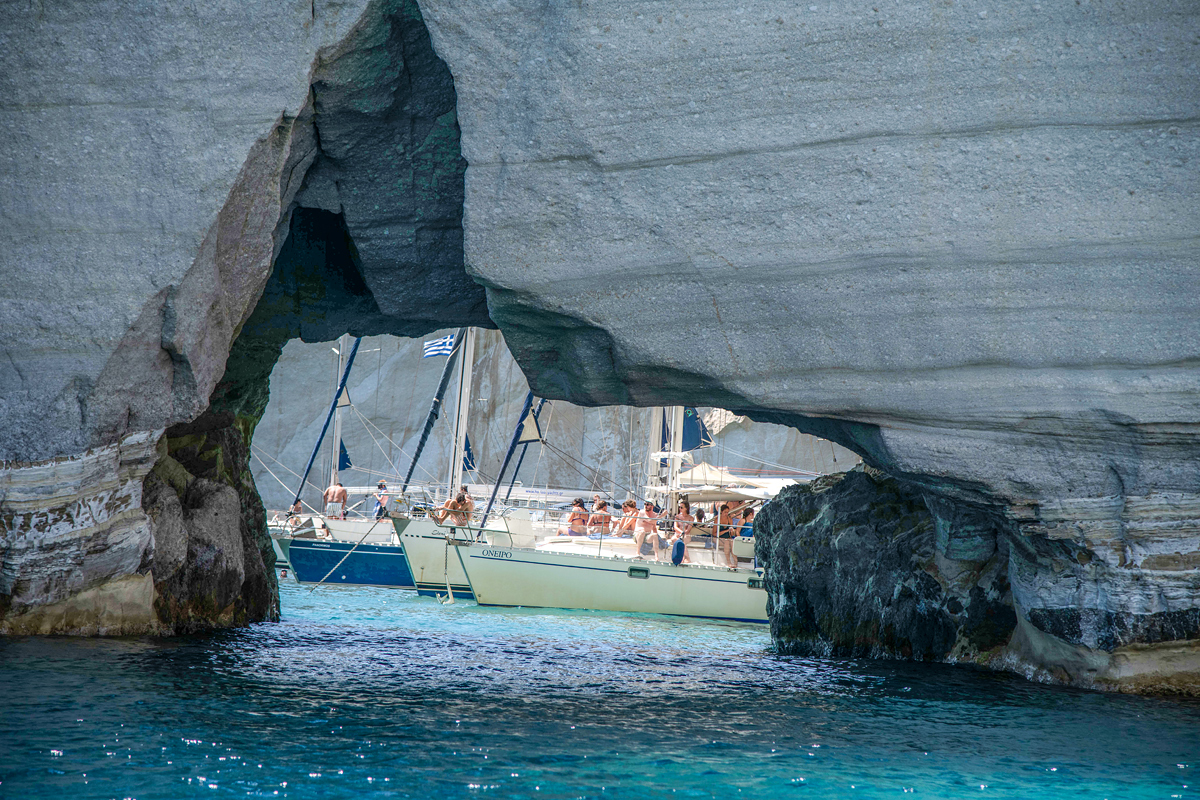
Image Source: Milos Boat Charters
A dramatic coastline hides a narrow passage in Kleftiko bay that whispers tales of piracy and adventure from centuries past. White rock formations tower over a forgotten tunnel that once gave seafaring outlaws a secret path to terrorize the Aegean waters.
The Historical Significance of the Tunnel
"Kleftiko" reveals its mysterious origins from the Greek word "kleftis," which means thief or robber. This secluded spot became a strategic hideout for pirates who ruled the Aegean Sea during the Middle Ages and Ottoman era. The tunnel's location along major maritime routes made it a perfect base for raiders.
Pirates thrived in this region whenever naval powers focused on their wars elsewhere. The dominant navies of Athens, Rhodes, Rome, Byzantium or Venice left gaps in their defense that pirates quickly filled throughout the Aegean. The natural shelter of Kleftiko's tunnel made it almost impossible for authorities to stop pirate activities.
The Greek revolution of 1821 marked the official end of pirate presence, as Admiral Kanaris secured the Aegean islands from these maritime raiders. The tunnel stands today as a reminder of how piracy shaped the culture and growth of these islands.
How Pirates Used This Hidden Passage
Pirates showed remarkable cunning in using this narrow tunnel. They waited inside to ambush merchant vessels and capture their valuable cargo. Ships could not spot them until the moment they struck.
These sea raiders left their mark by carving anchor points into the limestone rocks—modifications you can still see today. They stored their plundered treasures and supplies in the tunnel and connected caves. Multiple escape routes in the complex network of passages helped them dodge pursuing authorities.
The tunnel gave pirates several tactical advantages:
- Natural camouflage against the white limestone cliffs
- Quick access to open sea for rapid escapes
- Protection from harsh weather and violent storms
- Invisibility from lookouts positioned on higher elevations
Navigating the Narrow Tunnel Safely
Safety comes first when you visit this historical passage in 2025. Small boats or dinghies work best since larger vessels can't fit through the tunnel's tight spaces. Milos boat tours now use specialized small craft to take visitors from their main vessels into these narrow passages.
The tunnel's waters stay calm even during rough seas outside, which makes exploration easier. Tours provide basic gear, but guides suggest bringing:
- Waterproof footwear with solid grip
- Headlamps for darker sections
- Waterproof cameras to capture the unique interior
- Swimming gear for sections where navigation requires entering the water
What to Expect Inside
Light changes dramatically as you enter the pirate tunnel. Sunbeams pierce through small openings and create magical patterns on the white limestone walls. Water sounds echo inside, taking you back to the age of piracy.
Water erosion has shaped stunning geological formations over centuries. Some passages have such low ceilings that people must duck in their dinghies. Hidden chambers lie beyond these narrow sections where local legends say treasures might still rest in the caves.
Kleftiko milos tours let visitors swim through parts of the tunnel to experience the crystal-clear turquoise waters like pirates once did. Clear water offers great views of underwater features and small marine life that now call the tunnel home.
Photographers find dramatic opportunities in the tunnel's light and shadow play, especially during morning hours when sunlight angles perfectly inside. Milos private boat tours often plan visits around these ideal lighting conditions.
Glaronisia's Volcanic Archways: A Photographer's Dream
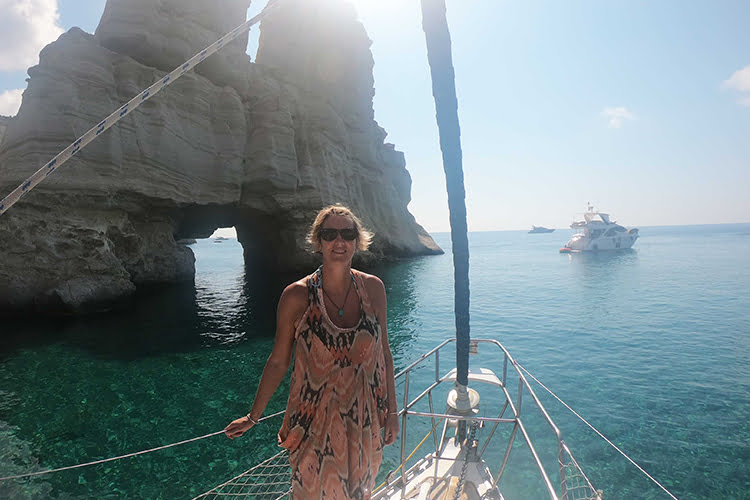
Image Source: Sue Where Why What
The volcanic columns of Glaronisia rise from the northern waters of Milos to create nature's most stunning archways. These "Seagull Islands," as their Greek name translates, show off rare geological formations you won't easily find anywhere else in the Mediterranean.
The Formation of These Unique Archways
Glaronisia's striking look comes from its columnar jointed basalt—vertical columns of volcanic rock formed approximately 700,000 years ago. Each column stands as a polygonal prism, shaped like hexagons or pentagons. These shapes emerged when volcanic lava contracted as it cooled. The formations look similar to Ireland's Giant's Causeway or Scotland's Staffa, but they get nowhere near as many visitors.
You'll find these islands less than 1km off Milos' north coast, made entirely of these striking vertical columns. The rock formations stand out because volcanic pressure pushed them into long, thin hexagonal columns that now tower from the blue waters, creating natural archways between them.
Best Angles for Photography
My milos private boat tours helped me find some great spots to capture these geological wonders:
- Shoot from diagonal angles instead of straight below to get dynamic upward views
- The golden hour light helps highlight the surface textures
- Put someone in your photos to show just how massive these formations are
- Wide-angle lenses work best to capture both the big picture and small details
Morning mist tends to soften the formations' edges, which creates dreamy images with more depth. My boat tour milos experiences taught me that backing away from the islands lets you frame them perfectly against the horizon.
Swimming Through the Archways
Swimming under these towering volcanic columns is the best way to experience Glaronisia up close. The water around the archways stays crystal-clear, making this milos boat tours stop perfect for underwater shots.
The water has shaped and smoothed the volcanic rock over thousands of years. Seagulls often nest above these formations between late spring and early summer. These birds gave the islands their name and made it their home.
Why These Formations May Not Last Forever
These magnificent structures ended up facing several threats. The volcanic composition makes them easy targets for sea and wind erosion. Climate research suggests rising global temperatures could speed up the weathering of these delicate formations through stronger storms.
Volcanic formations might look indestructible, but nature can wear them down. Taking milos boat tours in 2025 gives you a chance to see these remarkable geological wonders before they change forever.
Gerontas Cave: The Ancient Mariner's Shelter
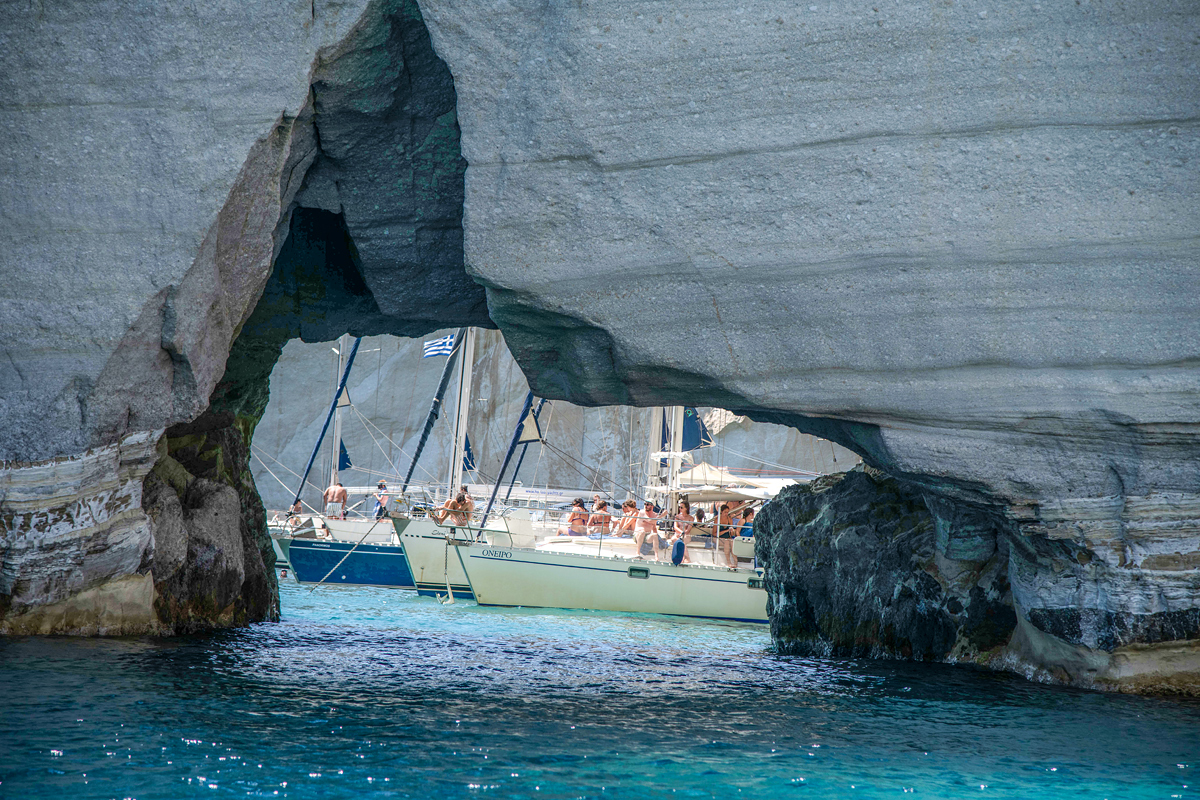
Image Source: Milos Boat Charters
Gerontas Beach lies on Milos' southern coastline, featuring a magnificent cave that served as a shelter for sailors who needed protection from the unpredictable Aegean waters. This natural wonder's stunning geological features and crystal-clear turquoise waters make it a highlight of many milos boat tours.
Historical Significance of Gerontas
The wild and uninhabited western area of Milos called Chalakas houses Gerontas, a natural haven for mariners through the ages. Its name means "old man" in Greek and suggests its ancient origins. The spot remains mostly available by sea and has protected sailors from harsh weather throughout Mediterranean maritime history.
The Hidden Beach Inside the Cave
The magic of Gerontas comes from its small hidden beach nestled inside the cave structure. Boat tour milos operators bring visitors through the sea entrance to see this pristine interior beach. A unique arch-shaped rock formation creates a natural bridge between sea and land. The beach stands out from others on the island with its darker volcanic sand that creates a dramatic contrast against the crystal blue waters.
Snorkeling Opportunities Around the Cave Entrance
The waters around Gerontas Cave are a great way to get amazing snorkeling experiences. Many milos private boat tour companies include this spot between visits to kleftiko milos because:
- The water clarity gives excellent visibility
- The cave entrance creates diverse marine habitats
- The protected waters stay calm even on windy days
Local Legends About the Cave
Stories tell us the cave sheltered not just sailors but sometimes pirates who roamed these waters. Many boats that pass through milos boat tours stops like Gerontas continue to Kleftiko's pirate hideouts, showing the deep connection between these locations in maritime folklore.
Most milos boat tours now include Gerontas in their routes, though visits are usually brief swimming stops. Summer months bring increasing numbers of visitors to this remote location, which shows its breathtaking natural beauty and importance as a historical refuge for mariners.
Triades' Secret Cove: The Beach That Disappears at High Tide
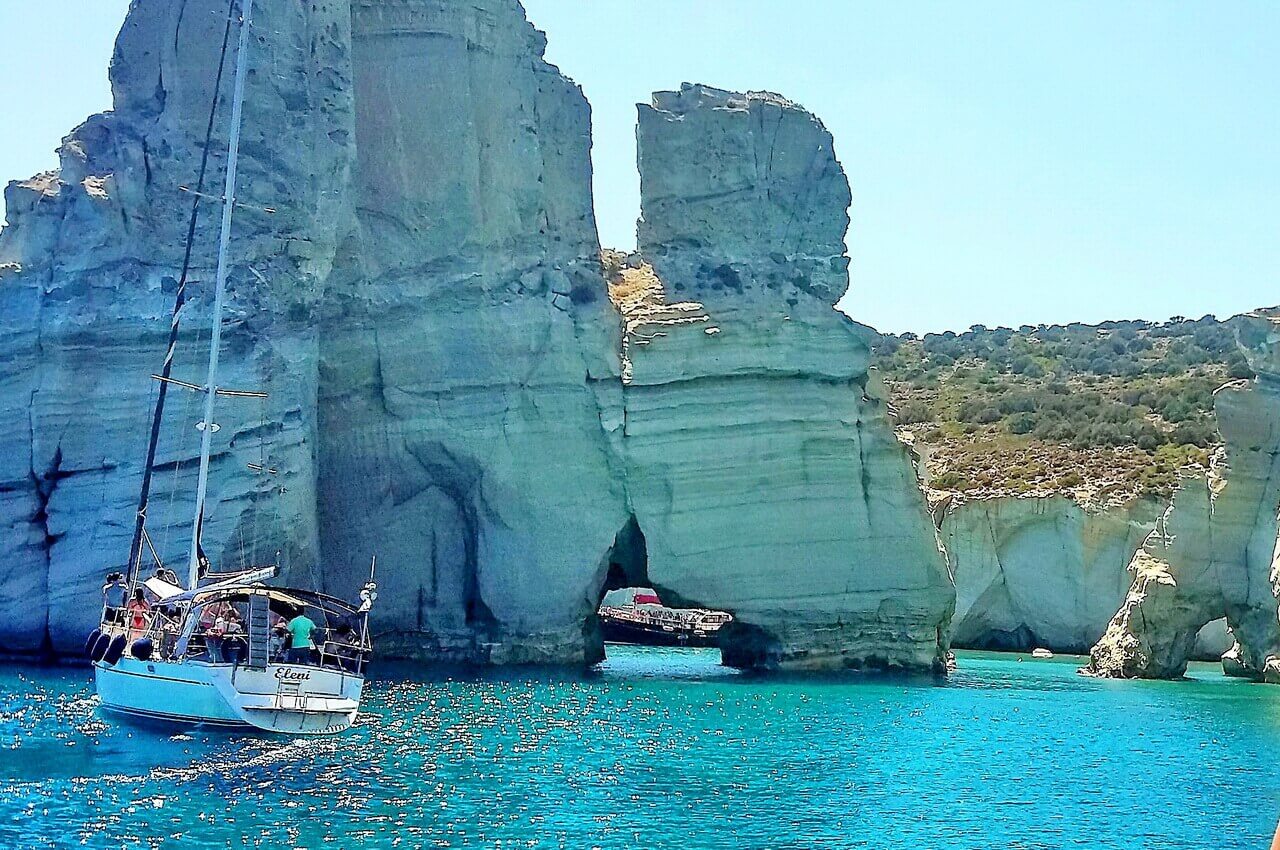
Image Source: Natania Travel
Three golden beaches known as Triades hide an extraordinary secret along Milos's northwest coast. One of these coves completely vanishes during high tide and reveals itself only to visitors who time their arrival just right.
Finding the Elusive Cove
The trip to Triades demands real effort. Visitors need to drive approximately 45 minutes from Adamantas through 8km of rough dirt road. The road ends near a small bar, and people must walk another 500 meters. Milos boat tours provide a more direct route to these secluded beaches.
"Triades" means "trinity" in Greek, which perfectly describes these three sandy coves divided by dramatic rock formations. Most visitors head straight to the first beach they see, which leaves the third cove—the one that plays hide and seek with the tides—almost untouched.
Tidal Patterns and Best Visiting Times
Timing matters a lot if you want to see the disappearing beach. The morning hours usually give you the best chance to see the hidden cove as the waters pull back. The afternoon brings rising waters that slowly cover parts of the beach until it disappears completely.
| Tide Condition | Beach Appearance | Best Activities |
|---|---|---|
| Low Tide | Fully exposed | Photography, exploration |
| Mid Tide | Partially visible | Swimming, snorkeling |
| High Tide | Submerged | Boat viewing only |
The Unique Red Sand Formation
Parts of Triades showcase stunning reddish sand that stands out against the crystal-clear turquoise waters. Iron oxide (hematite) creates this distinctive color. Just 0.1% hematite is enough to give the sand its striking red appearance.
Why This Spot Remains Hidden from Most Tourists
Triades stays secret and with good reason too. This beach ranks as one of Milos's most remote spots. The tough access route keeps casual tourists away. Lucky visitors who make the effort often get the entire beach to themselves.
Boat tour milos enthusiasts looking for pristine spots will find that this secret cove represents Milos's special charm—natural beauty that stays preserved because it takes effort to find.
Comparison Table
| Location | Access Method | Main Features | Best Time to Visit | Special Notes/Historical Significance | Current Status/Condition |
|---|---|---|---|---|---|
| The Mystical Blue Cave | Boat only | Natural skylight, turquoise waters, partially fallen ceiling | Sunset hours | A less crowded alternative to Italy's Grotta Azzurra | Visitors can swim, natural arch entrance |
| Sikia Cave's Hidden Chambers | Small boats/dinghies through narrow passage | Connected tunnels, stalactites, stalagmites, 30m high central chamber | Late afternoon | Features pristine rock formations and crystal waters | Temperature stays steady throughout the year |
| Polyaigos Hidden Lagoons | Private boats/charters | Stark white cliffs, turquoise waters, untouched beaches | June-September | The Cyclades' biggest uninhabited island, part of Natura 2000 network | Nature sanctuary with unique wildlife |
| Kleftiko's Forgotten Pirate Tunnel | Small boats/dinghies | Tight passages, secluded chambers, limestone walls | Early morning | Pirates once used this spot for ambushes | Original pirate-era changes still visible |
| Glaronisia's Volcanic Archways | Boat access | Basalt columns, natural archways | Golden hour | Dating back 700,000 years | Climate change poses erosion risks |
| Gerontas Cave | Boat only | Secluded beach inside, natural arch bridge, dark volcanic sand | Not mentioned | Ancient sailors found shelter here | Regular tours now visit this site |
| Triades' Secret Cove | 45-min drive + 500m walk or boat | Red sand shapes, three linked beaches | Morning at low tide | High tide submerges one beach | Limited access keeps this spot pristine |
Conclusion
Milos has coastal treasures that go beyond typical Greek island experiences. I explored seven amazing spots and found that each place tells its own story - from the mesmerizing Blue Cave that rivals Capri's famous grotto to the mysterious disappearing cove at Triades.
The right timing makes a big difference when you visit these natural wonders. The sunset creates magical light shows at Sykia Cave, and you can walk on Triades' hidden beach during morning low tides. The weather is perfect from June through September to swim in Polyaigos' clear lagoons and explore Kleftiko's old pirate tunnels.
These spots stay pristine because you can only reach them by boat. While tourists crowd other Greek islands, Milos keeps its treasures safe behind natural barriers and tough access points. Only adventurous travelers who go off the beaten path get to see this untouched beauty.
Climate change now threatens unique spots like Glaronisia's volcanic archways. That's why 2025 is the best time to see these natural wonders in all their glory. These seven hidden locations show why Milos stands out as one of Greece's most fascinating island destinations.
FAQs
Q1. What is the best way to explore Milos' hidden coastal spots?
The best way to explore Milos' hidden coastal spots is through private boat tours. These tours provide access to secluded caves, lagoons, and beaches that are inaccessible by land, offering a unique perspective of the island's stunning coastline.
Q2. When is the ideal time to visit Milos for boat tours?
The ideal time for boat tours in Milos is between June and September. This period offers the best weather conditions, with calm seas and warm temperatures perfect for swimming and exploring. June and September are particularly good for fewer crowds.
Q3. What makes the Blue Cave in Milos special?
The Blue Cave in Milos is special due to its natural skylight created by a partially collapsed ceiling. This unique feature allows sunlight to stream in, creating a mesmerizing blue glow in the water. Unlike similar caves, swimming is allowed here, making it a truly immersive experience.
Q4. Are there any wildlife spotting opportunities during Milos boat tours?
Yes, there are excellent wildlife spotting opportunities, especially around Polyaigos island. Visitors might encounter rare species like Mediterranean monk seals, endemic blue lizards, and various bird species including Eleonora's falcon. The crystal-clear waters also offer great visibility for marine life observation.
Q5. How long do typical boat tours around Milos last?
Typical boat tours around Milos can range from half-day excursions (about 5 hours) to full-day explorations (up to 10 hours). Full-day tours often combine visits to multiple hidden spots, including places like Kleftiko's sea caves and Polyaigos' lagoons, providing a comprehensive island experience.
